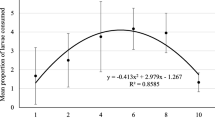Abstract
The conversion of aphid prey tissue (Acyrthosiphon pisum Harris) into predator biomass (immature life stages ofPropylaea 14-punctata L. andCoccinella 7-punctata L.) is calculated by plotting weight gain against assimilation (i.e. consumption minus egestion). This concept is added to the metabolic pool model byGutierrez et al. (1981) that enables the simulation of growth and development of a predator on a physiological basis. Physiological time is expressed in daydegrees above lower development thresholds for both species. Visual examination of observed and calculated values showed that the model satisfactorily describes the growth patterns of the above predators.
Zusammenfassung
Aus der Beziehung Produktion (Wachstum) zu Assimilation (Beuteverzehr-Kotproduktion) wird das Umwandlungsverhältnis berechnet, mit dem Blattlausgewebe in Räuberwachstum umgesetzt wird. Als Beute für die Larven vonPropylaea 14-punctata L. undCoccinella 7-punctata L. verwendete man die ErbsenblattlausAcyrthosiphon pisum Harris. Die physiologische Zeit ist in Tagegraden oberhalb eines unteren Entwicklungsnullpunktes angegeben. Für die beiden Coccinellidenarten wurden auf physiologischen Grundlagen Simulationsmodelle erarbeitet. Sie beschreiben das Wachstums und die Entwicklung eines Räubers und beruhen auf dem Konzept des vonGutierrez et al. (1981) vorgeschlagenen “metabolic-pool”-Modell. Die visuelle Beurteilung von beobachteten und berechneten Werten zeigt, dass das Modell das Wachstumsmuster der erwähnten Räuber auf befriedigende Weise beschreibt.
Similar content being viewed by others
References
Anonym. — 1981. PIR. Multiple linear regression, 237–250. In: BMDP Statistical Software 1981 Edition (W. J. Dixon, M. B. Brown, L. Engelmann, J. W. Frane, M. A. Hill, R. I. Jennrich & J. D. Toporek eds.). —Univ. California Press, Berkeley, 725 pp.
Asgari, A. — 1966. Untersuchungen über die im Raum Stuttgart-Hohenheim als wichtigste Prädatoren der grünen Apfelblattlaus (Aphidula pomi Deg.) auftretenden Arthropoden. —Z. Angew. Zool., 53, 35–93.
Bickel, H. — 1977. Der Futteraufwand in der Rindviehproduktion unter besonderer Berücksichtigung des Wirkungsgrades der Energieverwertung. —Schweiz. Landw. Fo., 16, 175–214.
Blackmann, R. L. — 1976a. The effects of different foods onAdalia bipunctata L. andCoccinella 7-punctata L. —Ann. Appl. Biol., 59, 207–219.
Blackmann, R. L. — 1976b. Selection of aphid prey byAdalia bi-punctata L. andCoccinella 7-punctata L. —Ann. Appl. Biol., 59, 331–338.
Bradfield, A. E. &Llewellyn, M. J. — 1982. Animal energetics. —Blackie, Glasgow and London, 168 pp.
Delucchi, V. Baumgaertner, J. & Bieri, M. — 1983. An integrated control approach for canning pea crop pests in Switzerland. —Proc. 10th Intern. Congr. Plant Protection, Brighton, England, 3, 1188.
Engelmann, L. — 1981. P9D. Multiway description of groups, 116–122. In: BMDP Statistical Software 1981 Edition (W. J. Dixon, M. B. Brown, L. Engelmann, J. W. Frane, M. A. Hill, R. I. Jennrich &J. D. Toporek, eds.). —Univ. California Press, Berkeley, 725 pp.
Gutierrez, A. P. &Baumgaertner, J. U. — 1984a. Multitrophic models of predator-prey energetics: I. Age sepcific energetics models: pea aphidAcyrthosiphon pisum (Harris) [Homoptera: Aphididae] as an example. —Can. Entomol., 116, 924–932.
Gutierrez, A. P. &Baumgaertner, J. U. — 1984b. Multitrophic models of predator-prey energetics: II. A realistic model of plant-herbivore-parasitoid-predator interactions. —Can. Entomol. 116, 933–949.
Gutierrez, A. P., Baumgaertner, J. U. &Hagen, K. S. — 1981. A conceptual model for growth, development, and reproduction in the Ladybird beetle,Hippodamia convergens [Coleoptera: Coccinellidae]. —Can. Entomol., 113, 21–23.
Gutierrez, A. P., Baumgaertner, J. U. &Summers, C. G. — 1984. Multitrophic models of predator-prey energetics: III. A case study in an alfalfa ecosystem. —Can. Entomol., 116, 950–963.
Hagen, K. S. — 1962. Biology and ecology of predaceous Coccinellidae. —Annu. Rev. Entomol., 7, 289–326.
Hagen, K. S. — 1974. The significance of predaceous Coccinellidae in biological and integrated control of insects. —Entomophaga, Mém. h. s., 7, 25–44.
Hodek, I. — 1958. Influence of temperature, rel. humidity and photoperiodicity on the speed of development ofCoccinella septempunctata L. (in Czech). —Acta Soc. Entomol. Cechoslov., 55, 121–141.
Hodek, I. — 1973. Biology of Coccinellidae. —Dr. W. Junk, The Hague, 260 pp.
Meier, W. — 1955. Das Auftreten und die Bekämpfung der Erbsenblattlaus (Acyrthosiphon pisum Harris) an Drescherbsen.Mitt. Schweiz. Landw., 3, 26–30.
Meier, W. — 1981. Ueber Befall-Schaden-Relationen bei Schädlingen in Feldkulturen. —Mitt. Schweiz. Landw., 29, 1–19.
Nakamura, K. — 1982. Prey capture tactics of spiders: An analysis based on a simulation model for spider's growth. —Res. Popul. Ecol., 24, 302–317.
Obrycki, J. J. &Tauber, M. J. — 1981. Phenology of three coccinellid species: Thermal requirements for development. —Ann. Entomol. Soc. Am., 74, 31–36.
Patrascanu, E. — 1964. Contribution à la connaissance de la biologie des InsectesAdalia bipunctata L. etPropylea 14-punctata L. —Lucr. stiint. Instit. agr. ‘Ion Ionescu de la Brad’, Iasi, 313–320.
Randolph, P. A., Randolph, J. C. &Barlow, C. A. — 1975. Age specific energetics of the pea aphid,Acyrthosiphon pisum. —Ecology, 56, 359–369.
Rogers, C. E., Jackson, H. B. &Eikenbary, R. D. — 1972. Responses of an imported coccinellid,Propylaea 14-punctata, to aphids associated with small grains in Oklahoma. —Environ. Entomol., 1, 198–202.
Sabelis, M. W. — 1981. Biological control of two-spotted spider mites using phytoseiid predators. I. —Pudoc, Wageningen, 242 pp.
Singhal, R. N. — 1976. Food energy budget for the ‘Ladybird’ beetle,Coccinella septempunctata L. —Intern. J. Ecol. Environ. Sci., 2, 97–106.
Sommer, V. — 1976. Zur Biologie derPropylaea 14-punctata Linné [Coleoptera: Coccinellidae]. — Diss. Johannes Gutenberg Univ. Mainz., 142 pp.
Suter, H. — 1977. Populationsdynamik der Erbsenblattlaus (Acyrthosiphon pisum Harr.) und ihren Antagonisten. —Diss. 5932 ETH, Zürich, 84 pp.
Suter, H. &Keller, S. — 1977. Oekologische Untersuchungen an feldbaulich wichtigen Blattlausarten als Grundlage für eine Befallsprognose. —Z. Angew. Entomol., 83, 371–393.
Author information
Authors and Affiliations
Rights and permissions
About this article
Cite this article
Baumgärtner, J., Bieri, M. & Delucchi, V. Growth and development of immature life stages ofPropylaea 14-punctata L. andCoccinella 7-punctata L. [Col.: Coccinellidae] simulated by the metabolic pool model. Entomophaga 32, 415–423 (1987). https://doi.org/10.1007/BF02372451
Received:
Accepted:
Issue Date:
DOI: https://doi.org/10.1007/BF02372451




